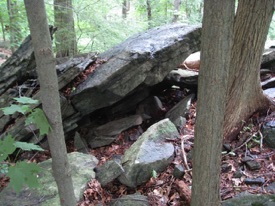Lovely Birds
* * *
* * *
* * *
Our Turkey Vulture Chick 6/24/2009
I have long known that black vultures nest in shallow caves among the boulders along the Princeton-Rocky Hill Ridge. I used to visit their nests near Crescent Rock and Cradle Rock, either side of Province Line Road, where it gives up being a road and turns into a dirt track winding its way up the steep ridge, just above Pretty Brook Road.

Jani came back from a walk up the ridge one June day to report that she had been startled when a vulture suddenly came flapping out of an outcropping of rock where our private trail joins the Watershed trail as it turns down the Hopewell side of the ridge. I knew right away what that meant, and sure enough, there were two mottled tan eggs lying in the leaf-litter under the rock.

There was also a black vulture nest among the boulders in the Seward Johnson Woods off of Stuart Road. All of these wild places have given way to MacMansions. You can’t walk there anymore, and the black vultures have moved on.
Our stretch of the ridge, a few miles further west, is still a wilder place, but in the ten years I’ve lived at Hillside, I’ve never found a vulture nesting among the boulders in our woods. Until this year.
From the mother vulture’s red head, it was clear that she is a turkey vulture. I never knew that they, too, nest in caves, as do their slightly smaller, gray-headed cousins, the black vultures
The eggs themselves seemed very similar to the black vulture eggs, but the black vulture chicks are a fluffy light brown color when they are born. A few days after Jani’s discovery, one of the turkey vulture eggs produced the snow white chick pictured above. Since the chick was born, we have hardly ever found the mother in the nest with it, though she is often somewhere nearby, perched on a branch in the canopy of oaks and tulip poplars, or circling on a thermal above the ridge. The second egg never hatched, and after about a week it disappeared. But the chick is always there, a little bigger and more mobile every day. It raises itself up, spreads its wings, and hisses when we come near the nest. (See “Growing & Molting”)